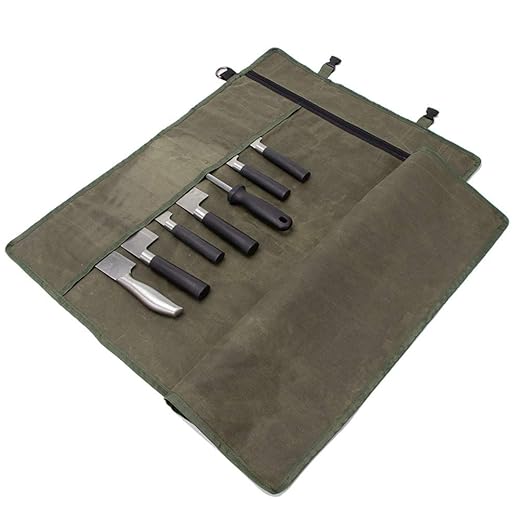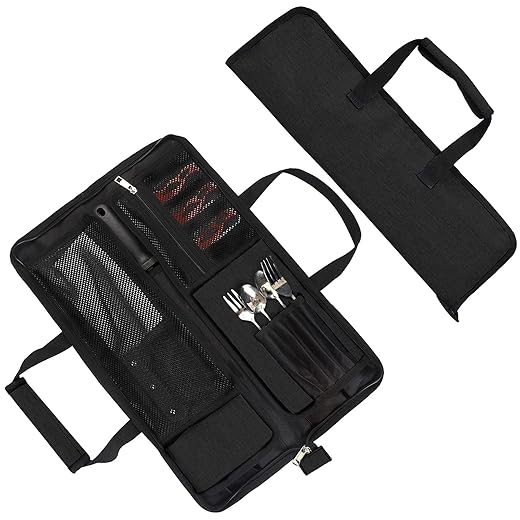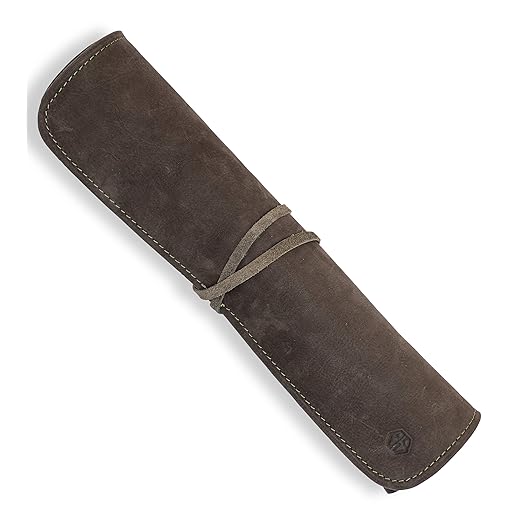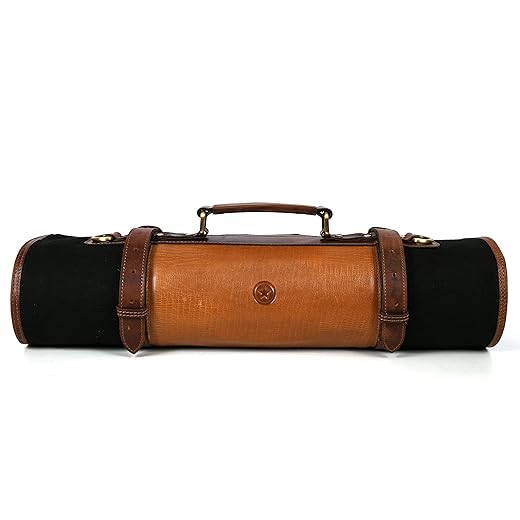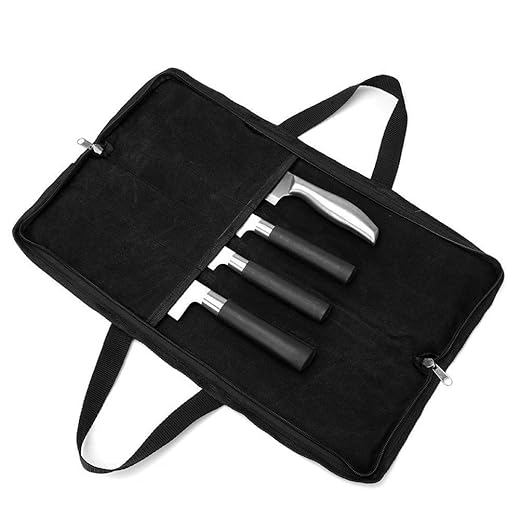A knife roll is a convenient and practical storage solution for chefs and culinary enthusiasts who need to transport their knives safely. It is a specialized carrying case designed to hold and protect knives of various sizes and styles.
A typical knife roll consists of a durable, often water-resistant fabric or leather material that is capable of withstanding the rigors of travel. It usually features multiple pockets or slots to securely hold individual knives, as well as additional compartments for storing other essential kitchen tools like honing rods, kitchen shears, or utensils.
The primary purpose of a knife roll is to provide a secure and organized method of transporting knives, whether it’s for professional chefs who need to bring their knives to different cooking locations or for home cooks who want to keep their knives neatly stored and protected. The roll design allows the knives to be rolled up and secured with straps or fasteners, ensuring they remain safely in place during transportation.
Knife rolls offer several advantages. Firstly, they help protect the knives from damage, such as blade dulling, chipping, or accidental contact with other objects. Additionally, they provide a compact and portable storage solution, allowing chefs to easily carry their knives while keeping them readily accessible. Knife rolls also help maintain the sharpness and longevity of the blades by preventing them from rubbing against one another.
Overall, a knife roll is an essential accessory for those who value the safety, organization, and mobility of their knife collection. It offers a convenient and efficient way to transport and store knives, ensuring they are kept in optimal condition and readily available for use in the kitchen or on the go.
Why use a knife roll?
A knife roll offers several advantages and benefits that make it a popular choice among chefs and culinary enthusiasts. Here are some reasons why you might choose to use a knife roll:
- Protection: A knife roll provides a secure and padded storage solution for your knives. It helps protect the blades from damage, such as chipping, dulling, or scratching, that can occur when knives are stored haphazardly or come into contact with other objects. The individual slots or pockets in a knife roll keep each knife separate, preventing them from rubbing against each other.
- Organization: A knife roll helps keep your knives neatly organized and readily accessible. With designated pockets or slots for each knife, you can arrange them in a systematic and orderly manner. This makes it easy to identify and retrieve the desired knife when you need it, saving you time and effort in the kitchen.
- Portability: If you often need to transport your knives, whether for culinary events, catering, or outdoor cooking, a knife roll is highly convenient. It allows you to securely store and carry your knives in a compact and portable manner. The roll design, often with straps or closures, keeps the knives safely in place during travel, reducing the risk of damage.
- Safety: Using a knife roll adds an extra layer of safety when handling and storing your knives. The roll design keeps the sharp edges of the blades covered, reducing the risk of accidental cuts or injuries. It provides a designated space for your knives, minimizing the chances of misplacing them or having them come into contact with other kitchen tools.
- Versatility: Knife rolls are designed to accommodate knives of various sizes and styles. They often feature multiple pockets or slots, allowing you to store a range of knives, from chef’s knives to paring knives and more. Some knife rolls may even have additional compartments for storing other kitchen tools or accessories.
Overall, using a knife roll offers convenience, protection, organization, and safety for your valuable knives. It helps prolong the lifespan of your blades, ensures they are readily available when needed, and provides a practical solution for transporting your knives.
Tags: leather knife roll, knife roll bag, chef knife roll, chefs knife roll
Are knife rolls good for knives?
Yes, knife rolls are an excellent storage solution for knives and offer several benefits that make them suitable for knife care. Here are some reasons why knife rolls are good for knives:
- Protection: Knife rolls provide a secure and padded environment for knives. The individual pockets or slots within the roll keep each knife separate, preventing them from coming into contact with each other, which can cause blade damage or dulling. The durable fabric or leather material of the roll helps protect the knives from external impacts or scratches.
- Organization: Knife rolls offer a well-organized storage system, allowing you to keep your knives neatly arranged and easily accessible. The individual pockets or slots in the roll keep each knife in place, making it simple to identify and retrieve the desired knife when needed. This helps prevent mishandling or accidental cuts that can occur when knives are stored haphazardly.
- Portability: Knife rolls are designed to be portable, making them ideal for chefs or culinary enthusiasts who need to transport their knives. The roll design allows you to securely roll up the knives and fasten them with straps or closures, ensuring they remain in place during travel. This portability is especially beneficial for professional chefs who often work in different locations or for those who like to take their knives on outdoor cooking adventures.
- Versatility: Knife rolls are available in various sizes, accommodating different knife lengths and styles. They typically have multiple pockets or slots, allowing you to store and protect a variety of knives, including chef’s knives, paring knives, utility knives, and more. Some knife rolls also feature additional compartments for storing other kitchen tools or accessories, adding to their versatility.
- Maintenance: By keeping knives stored in a knife roll, you can help maintain their sharpness and overall condition. The separation and protection provided by the roll prevent the knives from rubbing against each other or other objects, reducing the risk of blade damage. This can help prolong the lifespan of the knives and minimize the need for frequent sharpening.
Overall, knife rolls are designed to provide a safe, organized, and portable storage solution for knives. They offer protection, organization, and convenience, making them a good choice for keeping your knives in excellent condition and ready for use whenever you need them.
What knives should be in a knife roll?
The specific knives to include in a knife roll depend on your culinary needs and preferences. However, here are some essential knives that are commonly found in knife rolls:
- Chef’s Knife: A versatile, all-purpose knife with a broad blade and a sharp edge. It is suitable for chopping, slicing, dicing, and mincing various ingredients.
- Paring Knife: A small, maneuverable knife with a narrow blade, used for precise tasks like peeling, trimming, and intricate cutting.
- Utility Knife: A medium-sized knife that bridges the gap between a chef’s knife and a paring knife. It is handy for a variety of general cutting and slicing tasks.
- Bread Knife: A long, serrated knife with a narrow blade. It is designed for slicing through bread and other baked goods without crushing or tearing them.
- Boning Knife: A thin and flexible knife with a sharp point, used for separating meat from bones and trimming fat.
- Santoku Knife: A Japanese-style knife with a shorter, wider blade, suitable for slicing, dicing, and chopping. It is often used for vegetables and fish.
- Serrated Utility Knife: A smaller version of a bread knife with a serrated edge. It is useful for slicing tomatoes, citrus fruits, and other foods with delicate skins.
These are some of the basic knives commonly found in a knife roll. However, depending on your specific cooking style and preferences, you may also include other specialized knives like a carving knife, cleaver, fillet knife, or specialty knives for specific cuisines or techniques.
Consider the types of dishes you frequently prepare and the tasks you often perform in the kitchen to determine which knives would be most useful for you. Customize your knife roll with the knives that best suit your culinary needs.
Which way do knives go in a knife roll?
When placing knives in a knife roll, it is generally recommended to position them with the blade facing downward. This helps ensure safety and prevents accidental cuts when inserting or removing knives from the roll.
Here are some guidelines for properly arranging knives in a knife roll:
- Blade Downward: Place the knives in the roll with the sharp edge of the blade facing downward. This orientation reduces the risk of accidentally coming into contact with the sharp edge when reaching into the roll.
- Handle Extending: Allow the handles of the knives to extend out of the roll. This makes it easier to identify and grasp the desired knife when you need to retrieve it. It also provides a safe and secure grip when removing the knife from the roll.
- Individual Slots or Pockets: If your knife roll has designated slots or pockets for each knife, ensure that each knife is inserted into its corresponding slot. This helps keep the knives organized and prevents them from rubbing against each other, which can dull or damage the blades.
- Secure Fastening: Once all the knives are placed in the roll, securely fasten the roll using the provided straps, ties, or closures. This ensures that the knives remain in place and prevents them from shifting or falling out during transport.
It’s important to handle knives with care when placing them in or removing them from a knife roll. Always exercise caution to avoid accidental cuts or injuries. Additionally, follow any specific instructions or recommendations provided by the manufacturer for arranging knives in their particular knife roll model.
Remember to keep the knife roll closed and secured when not in use to protect the knives and maintain their safety.
What are knife rolls made of?
Knife rolls are typically made of durable and sturdy materials that provide protection for the knives while also being convenient for transport. The most common materials used in knife rolls include:
- Fabric: Many knife rolls are made of heavy-duty fabric such as nylon, canvas, or polyester. These materials are durable, lightweight, and water-resistant, offering good protection for the knives. They are also flexible, allowing the roll to be easily rolled up and secured.
- Leather: Some knife rolls are crafted from genuine leather or synthetic leather materials. Leather offers a premium look and feel and provides excellent protection for the knives. It is durable, resistant to tearing, and can withstand rough handling. Leather knife rolls often have a more elegant and professional appearance.
- Nylon/PVC Combo: Some knife rolls combine nylon fabric with a PVC (Polyvinyl Chloride) coating or lining. This combination enhances the durability and water resistance of the roll. The PVC coating adds a layer of protection against moisture and prevents the blades from piercing through the fabric.
The choice of material for a knife roll depends on personal preference, budget, and specific needs. Fabric knife rolls are popular due to their affordability, lightweight nature, and ease of cleaning. Leather knife rolls are favored for their durability, aesthetic appeal, and luxurious feel. Some knife rolls may also feature additional padding or insulation to provide extra protection for the knives.
When selecting a knife roll, consider the material’s quality, durability, and how well it can protect your knives during transportation and storage. Opt for a material that is easy to clean and maintain, and that meets your desired level of protection and style.
Do you need knife roll?
The need for a knife roll depends on your specific circumstances and requirements. Here are a few factors to consider when deciding whether or not you need a knife roll:
- Transportation: If you frequently need to transport your knives, whether it’s for professional purposes or cooking events, a knife roll can be highly beneficial. It provides a secure and organized way to carry your knives, protecting them from damage during travel.
- Knife Collection: If you own multiple knives of different types and sizes, a knife roll can help keep them organized and easily accessible. It allows you to neatly store your knives in individual slots or pockets, preventing them from rubbing against each other and potentially causing blade damage.
- Safety: A knife roll adds an extra layer of safety when handling and storing knives. It helps prevent accidental cuts or injuries by keeping the sharp edges of the blades covered and by providing a designated space for the knives.
- Convenience: A knife roll offers convenience and efficiency in the kitchen. It keeps your knives in one place, making it easy to find the desired knife quickly. It also reduces clutter and ensures that your knives are always within reach when you need them.
However, it’s important to note that a knife roll is not essential for everyone. If you have only a few knives and primarily use them in your home kitchen, you may find alternative storage options like a knife block or magnetic strip to be sufficient. Ultimately, the decision to use a knife roll depends on your personal preferences, knife collection, and specific needs for transportation, organization, and safety.
How do knife rolls work?
Knife rolls are designed to provide a secure and organized way to store and transport knives. Here’s how knife rolls typically work:
- Design: A knife roll consists of a flexible, fabric or leather material that is divided into individual pockets or slots to hold knives. The roll is typically long and rectangular in shape, with a fold-over flap or cover to protect the knives.
- Inserting Knives: To use a knife roll, you open it up and lay it flat. Each knife is inserted into its designated pocket or slot, with the blade facing downward and the handle extending out. The individual pockets keep the knives separate, preventing them from coming into contact with each other and causing damage.
- Rolling and Securing: Once the knives are placed in the pockets, you roll up the knife roll tightly, starting from one end. As you roll, the individual pockets neatly wrap around the knives, keeping them secure and preventing them from moving around. Some knife rolls have straps, ties, or closures that you can fasten to secure the rolled-up bundle.
- Transporting and Storing: With the knives securely rolled up, the knife roll is ready for transportation or storage. The compact and portable design of the roll allows you to carry it conveniently. The cover or flap provides an extra layer of protection, keeping the knives safe from external elements.
- Unrolling and Accessing Knives: When you need to use a knife from the roll, simply unroll it and lay it flat. The knives remain in their designated pockets or slots, making it easy to identify and access the desired knife. The handle of each knife extends out, allowing for a safe and secure grip when removing it from the roll.
Knife rolls are versatile and can accommodate various knife sizes and styles. Some knife rolls also feature additional compartments or pockets for storing other kitchen tools or accessories, such as sharpening stones, thermometers, or kitchen shears.
By using a knife roll, you can keep your knives organized, protected, and easily accessible, whether you’re at home, traveling, or working in a professional kitchen.
Are knife rolls safe?
Knife rolls are designed to enhance safety when handling and storing knives. Here are some aspects that contribute to the safety of knife rolls:
- Blade Protection: Knife rolls provide a secure enclosure for the blades, typically with individual pockets or slots for each knife. The pockets hold the blades in place and prevent them from coming into contact with other knives or objects, reducing the risk of accidental cuts or injuries.
- Handle Visibility: Knife rolls allow the handles of the knives to extend out, making it easy to identify and grasp the desired knife without directly handling the blade. This reduces the chances of accidental contact with the sharp edge of the blade, minimizing the risk of cuts.
- Secure Closure: Many knife rolls have straps, ties, or closures to secure the roll when it is rolled up. This ensures that the knives remain in place during transport or storage, preventing them from shifting or falling out. A properly secured closure adds an extra layer of safety and helps keep the knives protected.
- Portable Design: Knife rolls are designed to be portable, allowing for safe and convenient transport of knives. By using a knife roll, you can securely carry your knives without the risk of loose blades damaging other items or causing harm to yourself or others.
- Personal Awareness and Caution: While knife rolls provide a safe storage solution, it’s important to exercise caution and handle the knife roll with care. When unrolling or accessing knives from the roll, be mindful of the sharp edges and handle the knives with caution. Always ensure that the closure is properly secured to prevent the roll from unexpectedly opening.
As with any sharp objects, it’s essential to follow proper handling and storage practices when using a knife roll. By adhering to safety guidelines and exercising caution, you can safely and effectively use a knife roll to protect and transport your knives.
How do I choose a knife roll?
When choosing a knife roll, there are several factors to consider to ensure it meets your specific needs. Here are some important considerations:
- Size and Capacity: Evaluate the size of your knife collection and determine how many knives you need to accommodate in the knife roll. Ensure that the knife roll you choose has enough pockets or slots to hold your knives comfortably. Consider the length of the knives and the depth of the pockets to ensure a proper fit.
- Material and Durability: Look for a knife roll made of durable materials that can withstand regular use and provide adequate protection for your knives. Common materials include nylon, canvas, polyester, or leather. Consider the quality of the material, its resistance to wear and tear, and its ability to withstand moisture and impact.
- Safety Features: Check if the knife roll has secure closures, such as straps, ties, or zippers, to keep the knives in place during transport. Ensure that the closure mechanism is robust and reliable to prevent the roll from accidentally opening.
- Padding and Protection: Consider the level of padding and protection provided by the knife roll. Look for thick or reinforced padding between the knife pockets to prevent the blades from contacting each other. Adequate padding helps protect the knives from impact and reduces the risk of damage.
- Portability and Convenience: Assess the portability features of the knife roll. Look for a roll that is lightweight and easy to carry, with a comfortable handle or strap. Consider if the roll can be easily rolled up and secured for compact storage and transportation.
- Organization and Accessibility: Evaluate the organization features of the knife roll. Look for clear and identifiable pockets or slots that make it easy to locate and access specific knives. Consider additional compartments or pockets for storing other kitchen tools or accessories.
- Cleaning and Maintenance: Check if the knife roll is easy to clean and maintain. Look for materials that can be wiped clean or machine-washed if necessary. Consider if the roll is resistant to stains or odors that may accumulate over time.
- Budget: Set a budget range for your knife roll and look for options that provide the desired features within that range. Consider the value for money and the durability of the knife roll when assessing its price.
By considering these factors, you can choose a knife roll that fits your knife collection, provides adequate protection, and offers convenience in terms of portability, organization, and safety.
How long does knife roll last?
The lifespan of a knife roll can vary depending on factors such as the quality of the materials, frequency of use, care and maintenance, and the level of protection provided. With proper care, a well-made knife roll can last for several years or even longer. However, it’s important to note that knife rolls, like any other product, are subject to wear and tear over time.
To help extend the lifespan of a knife roll, consider the following tips:
- Choose a Durable Material: Opt for a knife roll made from high-quality and durable materials. Sturdy fabrics like nylon, canvas, or leather are commonly used in knife rolls and can withstand regular use.
- Proper Storage: When not in use, store your knife roll in a clean and dry environment. Avoid exposing it to excessive moisture or heat, as this can degrade the materials over time.
- Clean as Needed: Regularly clean your knife roll to remove any dirt, food particles, or stains. Follow the manufacturer’s instructions for cleaning, as some knife rolls may be machine-washable while others may require spot cleaning.
- Handle with Care: Handle your knife roll with care, especially when inserting or removing knives. Avoid forcing knives into tight pockets or applying excessive pressure, as this can damage the fabric or stitching.
- Avoid Overstuffing: While it may be tempting to fit as many knives as possible, avoid overstuffing the pockets or slots in your knife roll. This can cause strain on the material and increase the risk of damaging the knives.
- Regular Inspections: Periodically inspect your knife roll for any signs of wear or damage. Pay attention to the seams, stitching, and closures, and repair or replace any worn-out parts as needed.
- Protect the Knives: Ensure that the knives are clean and dry before inserting them into the knife roll. This helps prevent moisture buildup and potential damage to the fabric. Consider using blade guards or sheaths for extra protection.
It’s important to note that the lifespan of a knife roll can also depend on personal usage habits and individual care practices. By following these guidelines and taking proper care of your knife roll, you can help maximize its lifespan and enjoy its functionality for an extended period.
Should you buy knife roll?
In conclusion, a knife roll is a practical and efficient way to store, protect, and transport your knives. It provides a safe and organized solution for chefs, culinary enthusiasts, and professionals who need to carry their knives for various purposes.
By using a knife roll, you can:
- Keep your knives organized and easily accessible.
- Protect the blades from damage and maintain their sharpness.
- Minimize the risk of accidental cuts or injuries.
- Safely transport your knives, whether for travel or professional use.
- Extend the lifespan of your knives by providing proper storage and protection.
When choosing a knife roll, consider factors such as size, material, safety features, portability, and organization to ensure it meets your specific needs. With proper care and maintenance, a good-quality knife roll can last for many years, making it a worthwhile investment for any culinary enthusiast or professional chef.
Remember to handle your knife roll and knives with care, keep them clean and dry, and regularly inspect for any signs of wear or damage. By following these guidelines, you can enjoy the convenience and functionality of a knife roll while ensuring the longevity of your knives.
You May Also Like These Deals!
Best Kitchen Knife Set Black Friday Deals
Most of us are aware of how vital the right...
Read MoreBest Electric Knives Amazon Deals
If you are looking for the best electric knives Amazon...
Read MoreBest Pocket Knife Black Friday Deals
If you are in a hurry, check out this quick...
Read MoreProducts recommended in the post contain affiliate links. We may receive a commission when you buy something through our posts.
Why Trust Us
You will find what you are looking for at Black Friday Weeks. From classic to luxury brands, you'll find both. We will help you to select appliances that fit your needs, budget and lifestyle. Whether you want to stop by to learn more — or plan to make a major purchase — we’ll treat you like family and assist you every step of the way. Shop with us today to receive friendly and experienced help along the way.


